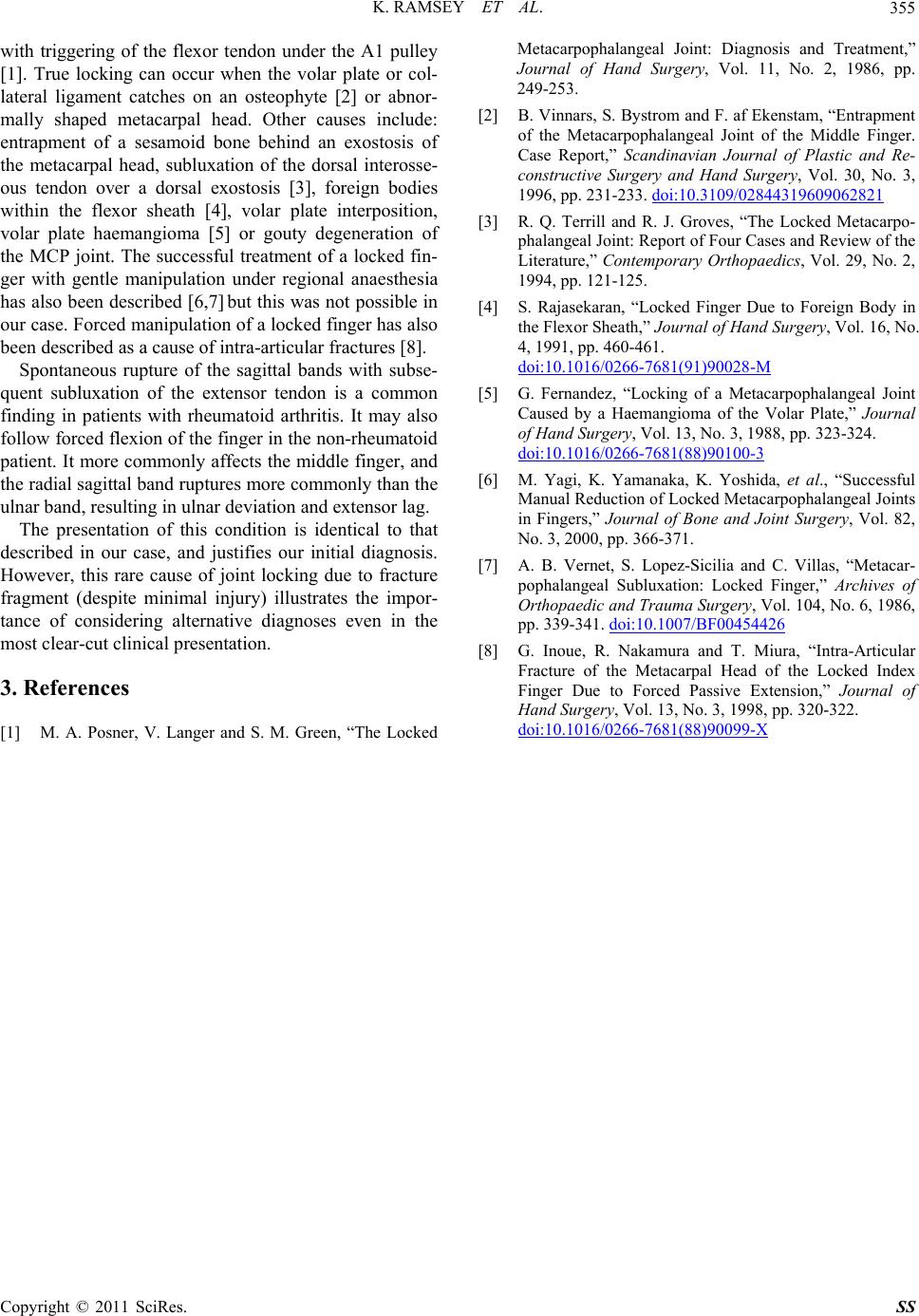
K. RAMSEY ET AL.
Copyright © 2011 SciRes. SS
355
with triggering of the flexor tendon under the A1 pulley
[1]. True locking can occur when the volar plate or col-
lateral ligament catches on an osteophyte [2] or abnor-
mally shaped metacarpal head. Other causes include:
entrapment of a sesamoid bone behind an exostosis of
the metacarpal head, subluxation of the dorsal interosse-
ous tendon over a dorsal exostosis [3], foreign bodies
within the flexor sheath [4], volar plate interposition,
volar plate haemangioma [5] or gouty degeneration of
the MCP joint. The successful treatment of a locked fin-
ger with gentle manipulation under regional anaesthesia
has also been described [6,7] but this was not possible in
our case. Forced manipulation of a locked finger has also
been described as a cause of intra-articular fractures [8].
Spontaneous rupture of the sagittal bands with subse-
quent subluxation of the extensor tendon is a common
finding in patients with rheumatoid arthritis. It may also
follow forced flexio n of the finger in the non-rh eumatoid
patient. It more commonly affects the middle finger, and
the radial sagittal band ruptures more commonly than the
ulnar band, resulting in ulnar deviation and extensor lag.
The presentation of this condition is identical to that
described in our case, and justifies our initial diagnosis.
However, this rare cause of joint locking due to fracture
fragment (despite minimal injury) illustrates the impor-
tance of considering alternative diagnoses even in the
most clear-cut clinical presentation.
3. References
[1] M. A. Posner, V. Langer and S. M. Green, “The Locked
Metacarpophalangeal Joint: Diagnosis and Treatment,”
Journal of Hand Surgery, Vol. 11, No. 2, 1986, pp.
249-253.
[2] B. Vinnars, S. Bystrom and F. af Ekenstam, “Entrapment
of the Metacarpophalangeal Joint of the Middle Finger.
Case Report,” Scandinavian Journal of Plastic and Re-
constructive Surgery and Hand Surgery, Vol. 30, No. 3,
1996, pp. 231-233. doi:10.3109/02844319609062821
[3] R. Q. Terrill and R. J. Groves, “The Locked Metacarpo-
phalangeal Joint: Report of Four Cases and Review of the
Literature,” Contemporary Orthopaedics, Vol. 29, No. 2,
1994, pp. 121-125.
[4] S. Rajasekaran, “Locked Finger Due to Foreign Body in
the Flexor Sheath,” Journal of Hand Surgery, Vol. 16, No.
4, 1991, pp. 460-461.
doi:10.1016/0266-7681(91)90028-M
[5] G. Fernandez, “Locking of a Metacarpophalangeal Joint
Caused by a Haemangioma of the Volar Plate,” Journal
of Hand Surgery, Vol. 13, No. 3, 1988, pp. 323-324.
doi:10.1016/0266-7681(88)90100-3
[6] M. Yagi, K. Yamanaka, K. Yoshida, et al., “Successful
Manual Reduction of Locked Metacarpophalangeal Joints
in Fingers,” Journal of Bone and Joint Surgery, Vol. 82,
No. 3, 2000, pp. 366-371.
[7] A. B. Vernet, S. Lopez-Sicilia and C. Villas, “Metacar-
pophalangeal Subluxation: Locked Finger,” Archives of
Orthopaedic and Trauma Surgery, Vol. 104, No. 6, 1986,
pp. 339-341. doi:10.1007/BF00454426
[8] G. Inoue, R. Nakamura and T. Miura, “Intra-Articular
Fracture of the Metacarpal Head of the Locked Index
Finger Due to Forced Passive Extension,” Journal of
Hand Surgery, Vol. 13, No. 3, 1998, pp. 320-322.
doi:10.1016/0266-7681(88)90099-X